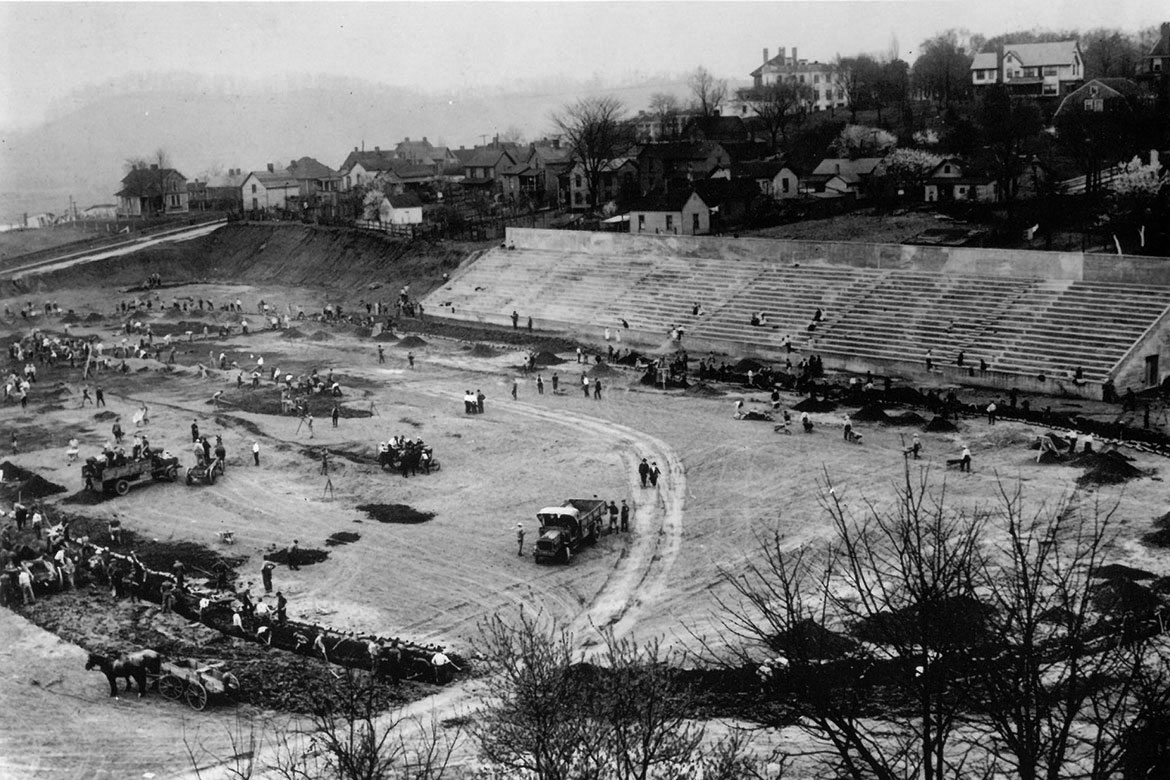Let me make these things perfectly clear: I am an expert on old age. Neyland Stadium does not look to be 100 years old. The reason is it isn’t.
No matter what University of Tennessee public relations people tell you, no matter what the school does in the forthcoming centennial celebration, the great arena beside the river is not 100. The historic playground, Shields-Watkins Field, is.
There was almost no stadium in 1921. There were 17 rows of wooden benches on a concrete foundation. It remains in place.
Gus Manning, to this day, insists the field and stadium are different entities. Bud Ford, long in sports information service, knows the difference. Vol historian Tom Mattingly says amen.
The green, green grass and marvelous memories that came from a very humble beginning are among the most intriguing success stories in college athletics. The area was once a vacant, forlorn sight and site, gullies, rocks, weeds and piles of dirt.
Excavation for construction of Ayres Hall made a mess. Dean Nathan Washington Dougherty said it was OK to dump excess dirt at the bottom of the hill. Nobody cared.
The idea for a physical education and athletic field “down there” goes back to 1912. University Realty was formed and acquired an option on seven acres. Over the next few years, there was occasional talk but no action.
In 1917, contributions for development were solicited. Gifts averaged almost $10. The UT students’ organization pledged money and labor – for a time to be determined. Those who came up with that plan had no fear of hard work, sweat and blisters. They figured they would be long gone.
In 1919, a new member of the board of trustees stirred the pot. Colonel W.S. Shields, president of City National Bank, offered to pay the $22,453 the realty company owed on the property if the university matched the donation and made something happen. Shields purchased and added two adjoining parcels. We think his investment exceeded $40,000 – cash on the barrel head.
That was the first serious phase of progress. It took a while but more fill dirt and borrowed road-building equipment almost leveled the area. Dr. H.A. Morgan, university president, declared March 16, 1921, as field day, a holiday from classes so interested students and faculty could “complete the field.”
Contrary to rumor, I was not there. Roy “Pap” Striegel, captain of the 1922 team, provided the report. He said there was a crowd picking up rocks. He said there was a ditch-digging contest to put in drainage. He said the girls from the home economics department served lunch.
The way Pap said that might not be socially acceptable today.
Trustees bestowed the name “Shields-Watkins Field” in honor of the Colonel and his wife, Alice Watkins Shields. Trustees voted to build permanent seats. Two opposed. They thought $20,000 for 3,200 places for fans to sit down was absolute extravagance.
The first game, that Sept. 24, Tennessee 27-0 over Emory and Henry, fell far short of a sellout.
Robert Reese Neyland arrived in 1925 as an ROTC instructor and end coach. He received whatever teacher pay was plus $750 for coaching. He became head coach a year later. His success led to four stadium expansions in 13 years.
Seats around Shields-Watkins Field could accommodate 31,390 fans in 1938. There was a big increase in 1948. The westside upper deck was added in 1962.
Trustees told Neyland they intended to name the stadium in his honor that fall. He said no big deal. The General thought Tennessee football was about players, fundamentals and execution – and not him.
The General didn’t live to see the ceremony. He died that March 28. The summation of all that is Neyland never coached a game at Neyland Stadium.
Robert Reese Neyland Jr. spoke at the dedication of the great house his dad built. That’s the warm, fuzzy part. If you insist on cold, hard facts, Alabama won the game, 27-7.
Through the years, some interesting things happened on Shields-Watkins Field. The streak of shutout victories was among the highlights.
Johnny Butler made The Run, a serpentine classic, 56 yards back and forth, on Oct. 21, 1939. Grantland Rice said the Vol tailback was “a dancing, dodging, untacklable ghost.”
Charlie Severance, Wayne Grubb and Bill Majors stopped LSU’s Billy Cannon short of the goal on a two-point conversion try, northeast corner, Nov. 7, 1959. Cannon said he scored.
In the southeast corner, Larry Seivers made the two-point catch that beat Clemson in ’74. Gus Manning was there, cigar and briefcase, co-star in a classic photograph.
There was the adventure with artificial turf and Georgia’s threat to not play on that stuff. It was Doug Dickey’s idea to have orange and white end zone checkerboards.
Condredge Holloway’s rushed return from a hospital emergency room and his insistence on rejoining the fray was courage personified. The Billy Ratliff hit at the Arkansas 43 and the stumble and fumble made the perfect season and the 1998 national championship season possible.
For many other reasons, the Tennessee arena is an extraordinary place. Amphibious fans arrive by boat. There is a bronze statue of The General, larger than life. Players still recite his maxims.
Great single-wing tailbacks – Gene McEver, Beattie Feathers, George Cafego, Hank Lauricella and John Majors – followed blockers all the way to the College Football Hall of Fame.
Bob Suffridge, Doug Atkins, Reggie White, Steve Kiner and Peyton Manning played there. Bobby Denton, unforgettable voice on the public address system, revealed concession prices and said “pay no more.”
From his dorm room on the east side, star blocking back Jimmy Hahn once shot out a street light that bothered his sleep. Broken glass showered down on a campus policeman.
John Ward said “No-sir-ree” when he decided a Florida kick missed the mark. Bob Campbell pampered and nurtured real grass in the transformation from plastic turf.
Deannie Hoskins was the first great grass-keeper. One July, Neyland asked if the field would be ready.
Hoskins said, “My field is always ready. What matters is will your football team be ready?”
It was.
Marvin West welcomes reader comments or questions. His address is marvinwest75@gmail.com

